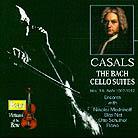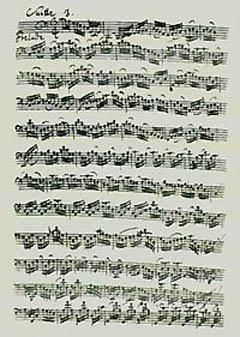April 1999
Perhaps, instead, one should look to other areas. Why, for instance, do so many people take pleasure from the recordings of Robert Johnson, also made in the '30s (and on equipment which, even then, was far from state-of-the-art), or those of Bix Beiderbecke from the 1920s? Perhaps Hartley did have the answer -- they really did do things differently then. Certainly, before the age of mass communications and rapid travel, there was a lot more room for individuality than in today's glossy, image-driven free market. It is extraordinary to realize that only a century ago the cello suites of Johann Sebastien Bach, now universally regarded as the very pinnacle of the instrument's repertoire, were all but unknown. Their rehabilitation is due to one man: Pablo Casals. When, at the age of 13, he first discovered the suites, in a small music shop in Barcelona, he said: "I did not even know that they existed, neither did my teacher, and no one had ever spoken to me about them. It was the great revelation of my life." Before Casals, the suites were regarded (when they were regarded) as little more than technical exercises. Casals studied the music for 12 years in private before beginning to play them in their entirety in public. Although he recorded four movements from the C major suite acoustically in 1915, it was not until the mid 1930s, and then only after considerable persuasion by the legendary Fred Gaisberg (who first recorded Caruso, later Schnabel), that Casals finally agreed to record all six of the suites complete. By this time he was in his early 60s and had been playing the music for over four decades. The recordings, made in three pairs, each happened on a single day -- in 1936 (suites 3 & 2), 1938 (1 & 6) and 1939 (4 & 5) -- and have seldom, if ever, been out of the catalog since. They truly constitute one of the great recordings of all time. To my mind there are three possible justifications for reissuing material that is already on the market (as the suites are, on two EMI discs): superior transfers, additional material, or reduced cost. Pearl's new transfer beats EMI's on the first two, although the discs are more expensive than EMI's. The additional material, in the form of half a dozen "encore" pieces in arrangements for cello and piano, are quite strange -- who today would consider transcribing a Bach organ piece for such a combination? Yet the first track here is Casals' own arrangement (from the piano transcription by Siloti) of the Adagio from Bach's Toccata, Adagio and Fugue, BWV 546. Strangely enough (well, perhaps not given Casals' musicianship), these encores, although ultimately disposable, work very well. They also comprise an additional 20-some minutes of music. The meat, of course, is in the cello suites. Pearl presents them here in the order they were recorded -- 3, 2, 1, 6, 4, 5 -- which is an interesting idea, although I'm not sure how much it adds to the listening experience. Not that much could be added -- Casals' playing is superb. The original 78-RPM matrix numbers show that most of the tracks here are first takes, with the remaining being second takes. Given the impossibility of editing 78-RPM masters, this speaks volumes for Casals' technique.
As to Casals' musicianship, these performances remain, after six decades, a touchstone for all others. Many cellists have recorded the suites since Casals. Quite a few have recorded them twice, one or two even three times. And yet Casals' performance have never been surpassed. Whether it is in the skipping-dance movements, the searching preludes, or the profound and deeply moving slow movements, Casals seems to dig deeper into the music than anyone else. As good as the (uncredited) EMI transfer is, Pearl's, by Seth B. Winner studios, strikes me as even better. They must have used remarkably clean copies of the original discs, for surface noise is very low (and Pearl does not approve of massive filtering to remove it). But what impressed me most of all is the sheer physicality of the sound of the cello itself. Although one must make a few allowances for the age of the recording, they are very few. Unless your ears are irretrievably wedded to digital stereo sound (shame on you!), then the sound of these transfers if unlikely to offend. I, for one, still take enormous pleasure in listening to recordings made decades before I was born. Whatever their technical shortcomings, many of them contain more music than most current offerings. And some, like this selection, tower so high above the competition as to make issues of sound alone irrelevant. This is unquestionably some of the greatest playing ever put on record, and it has never sounded better than in these new transfers. Essential. GO BACK TO: |
 Pablo Casals - The Bach
Cello Suites
Pablo Casals - The Bach
Cello Suites![[Reviewed on CD]](../format/regcd.gif) Why
listen to recordings made in the 1930s when there are many modern recordings of the same
piece? On the one hand, I could simply quote L.P.Hartley and say that "the past is a
foreign country, they do things differently there"; on the other, I could present all
sorts of reasons why musicians of earlier generations were more in touch with certain
aspects of the music, but that would start to sound as if I were harking back to a
"golden age."
Why
listen to recordings made in the 1930s when there are many modern recordings of the same
piece? On the one hand, I could simply quote L.P.Hartley and say that "the past is a
foreign country, they do things differently there"; on the other, I could present all
sorts of reasons why musicians of earlier generations were more in touch with certain
aspects of the music, but that would start to sound as if I were harking back to a
"golden age." 